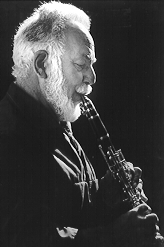
Click over Logo to return to Home Page
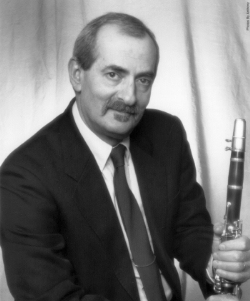
12 December 2006
In Memoriam - Kenny Davern - Jazz Clarinetist
Sandia Park, New Mexico
John Kenneth Davern (born
January 7,
1935, died
December
12, 2006)
better known as Kenny Davern is one of the premier
jazz
clarinetists
of his generation. Kenny died of a heart attack at his Sandia Park, New Mexico
home.
He was born in
Huntington,
Long
Island to a family of mixed Jewish and Italian-Catholic ancestry. His
mothers family originally came from
Vienna,
Austria, were
his great-grandfather Alfred Roth had been a
colonel in
the
Austro-Hungarian
cavalry, the
highest rank accessible to a Jew in the
Habsburg
Imperial army.
After hearing
Pee Wee Russell the first time, he was convinced that he wanted to be a jazz
musician, too; and at the age of 16 he joined the musician's union, first as a
baritone saxophone player. In 1954 he joined
Jack Teagarden's Band, and after only a few days with the band he made his
first jazz recordings. Later on, he worked with bands lead by
Phil
Napoleon and
Pee Wee Erwin before joining the
Dukes of Dixieland in 1962. The late 1960s found him free-lancing with a.o.
Red Allen,
Ralph
Sutton,
Yank
Lawson and his life-long friend
Dick Wellstood.
At this time, he had also taken up the
soprano saxophone, and when a spontaneous coupling with fellow reedman
Bob Wilber
at Dick Gibson's Colorado Jazz Party turned out be a huge success, one of the
most important jazz groups of the 1970s, Soprano Summit, was born. Co-led
by Wilber and Davern, both switching between the
clarinet
and various
saxophones, during the next five years Soprano Summit enjoyed a very
successful string of record dates and concerts. When the group disbanded in
1979, Davern devoted himself to solely playing
clarinet,
preferring trio formats with
piano and
drums. His
collaboration with Bob Wilber was revived in 1991, the new group being called
Summit Reunion. Leading his own quartets since the 1990s, Davern has
preferred the
guitar to the
piano in his
rhythm section, employing guitarists
Bucky Pizzarelli,
Howard
Alden and
James Chirillo.
In 1997, he was inducted into the Jazz
Hall of
Fame at
Rutgers University, and in 2001 he received a honorary doctorate of music at
Hamilton College,
Clinton, New York. In addition to the jazz greats that inspired him, Kenny
Davern indicates classical clarinetist David Weber, principal solo clarinetist
with the
New York City Ballet Orchestra, as his most important teacher.
Although playing mainly in
traditional jazz and
swing
settings, his musical interests encompass a much broader range of styles. In
1978 he collaborated with avantgarde players
Steve Lacy,
Steve
Swallow and
Paul
Motian on a
free jazz-inspired
album appropriately entitled Unexpected. In addition to his
accomplishments in jazz, his ardour and knowledge of
classical music is encyclopaedic, particularly of the work of conductor
Wilhelm Furtwängler.
Especially since he has been concentrating on exclusively playing the
clarinet,
Kenny Davern has been calling his own an unmatched mastery of the instrument. A
full, rounded tone, especially "woody" in the lower
chalumeau
register, combined with highly personal tone inflections and the ability to hit
notes far above the conventional range of the
clarinet,
have made his sound immediately recognizable. In the late 1980s, the
New
York Times hailed him as 'the finest jazz clarinetist playing today'.
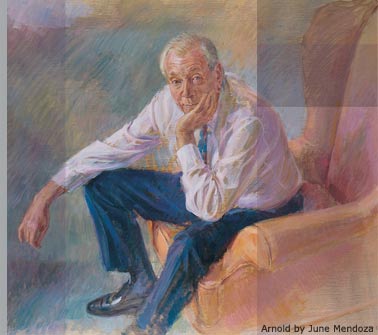
26 September 2006
|
|

Sir Malcolm Arnold was most famous for his film scores
|
British composer Sir Malcolm Arnold has died in hospital after a brief
illness at the age of 84.
Sir Malcolm, who won an Oscar for the musical score to the Bridge on the
River Kwai film in 1958, was suffering from a chest infection. He is most
famous for his film scores, composing 132 including Whistle Down the Wind
and Hobson's Choice.
Sir Malcolm, who lived near Norwich, also composed seven ballets, nine
symphonies and two operas.
Sir Malcolm, one of the most famous composers of the 20th Century, leaves
behind two sons and one daughter. He died at the Norfolk and Norwich
Hospital.
 |
 Sir Malcolm, you could be responsible for my lifelong love of
real music
Sir Malcolm, you could be responsible for my lifelong love of
real music

|
Anthony Day, his companion and carer for the last 23 years, praised Sir
Malcolm as "the most wonderful man".
"People didn't see the man that I knew because he had frontal lobe
dementia over the last few years which slowly developed but, being with him,
he was a happy, lovely man who enjoyed his music and enjoyed his life," he
told BBC News.
Mr Day also paid tribute to Sir Malcolm's achievement in winning an Oscar
for Bridge on the River Kwai.
"They couldn't find anybody else to do the music in time because they
wanted to release it to the Oscars," Mr Day said.
"They gave him 10 days and he managed to write the complete score in 10
days."
 |
 He was a happy, lovely man who enjoyed his music and enjoyed his
life
He was a happy, lovely man who enjoyed his music and enjoyed his
life

|
Cellist Julian Lloyd Webber described Sir Malcolm as a "genius" who was
never entirely appreciated.
He said: "I think he was a very, very great composer but uneven in his
output.
"Because he had humour in his music he was never fully appreciated by the
classical establishment."
Lord Attenborough, the director and actor, said Sir Malcolm was a
"totally outstanding composer".
Sir Malcolm's music continues to be performed and recorded extensively by
leading orchestras both nationally and internationally.
He was awarded the CBE in 1970.
Saturday night was the premier of his version of the Three Musketeers at
the Alhambra in Bradford.
The performance, which was dedicated to him, went ahead as planned
Tributes:
I am a clarinettist who has played some of Malcolm Arnold's work ...
which is some of the most challenging and yet most rewarding I have worked
on. He was a great composer and knew my instrument well.
Eleanor Smith, Edinburgh
As one of Malcolm's biographers I got to know him very well in his final
years. In spite of his shameful treatment by the music critics who berated
him for being popular, he lived to see virtually all of his output recorded
and what is more selling well! More than any other composer I have known,
the music was the man. He may no longer be with us but listen to his music
to know what we have lost.
Paul RW Jackson, Winchester, Hampshire
Malcolm Arnold was one of the greatest symphonists that this country has
been fortunate to have had. He combined excellent technique with a vast
amount of humour (humour is a difficult object to achieve in music, unless
one wishes to indulge in pure pastiche), to create symphonies and other
works that will last. Arnolds technique included extremely subtle tonality
and key-play within this framework, along with highly original orchestration
that is challenging to play (I played French Horn in amateur orchestras and
brass bands, and have played in some of Arnolds works). The humour, I feel,
was not an attempt to cock a snook at the musical Establishment, rather it
was an expression of a man, a vital man and an insouciant man, confident in
his own abilities and not one who fawned on approval, who lived, breathed
and sweated music, and was not worried if the sweat produced a bit of a
stink.
Steve Robey, Harwich UK
A composer of great courage, who stuck to his principles despite the
fashionable barrage of atonality. Of composers born in the 1920's, virtually
all gave in to the pressure of the establishment. Malcolm Arnold stood firm,
and he alone kept the flame of classical music alive until a younger
generation came along to breathe new life into the genre once more. Good
though his film music is, his concert music is his real contribution. Among
many works, maybe the Second and fifth Symphonies stand out, together with
many of the concertos. He paid a terrible price for standing firm against
the tyranny of the establishment, but all who care about serious music
should be grateful to him for helping contemporary serious music to survive
to our day.
Michael Holley, Goring on Thames, Reading, UK
Sir Malcolm was a unique voice in dramatic and concert work, with a
distinctive bittersweet yet tingling way with his harmony and orchestration.
He was a great musical satirist and educator too, a tonal 'people's
composer' who nonetheless never dumbed-down. He also weathered the vortex of
many personal challenges in his inner and outer life. His music increasingly
appeals and will continue to do so, no doubt outlasting the canards of a
musical establishment who frequently underrated him.
William McCrum, Templepatrick, N. Ireland
When I read the news I took the score for the Symphony No.6 from my
shelf, the first major score by Malcolm Arnold I ever studied, which I still
regard fondly. In America, his legacy will certainly be kept alive in his
marvellous compositions for wind ensemble, whose orchestrations never cease
to amaze. He will be missed.
Bill Sisson, Onalaska, Wisconsin, United States
I became enamoured of Sir Malcolm's music when in college in Wisconsin in
the early 1980s. I was classical music director of the local 10 watt radio
station, and a couple who were patrons and supplemented our meagre budget
had me over to listen to their $20,000 system at various times. It was on
one of those occasions that I heard my first Lyrita recording. It was
Malcolm Arnold's "Dances," and after that I bought every recording of his
works I could lay my hands on, and I was never disappointed. He may not have
been as well known or widely appreciated by Americans in general, but among
those of us who appreciate the wonders of 20th Century British Classical,
his name has always been a standout. He will be missed.
Victor Davis, Napa, California, USA
"Four Cornish Dances" - Shivers down me spine - Especially the march
where it pictures walking down to the chapel on a Sunday morn, Methodist
style with the sea in the background and a pint of cider waiting at the
bar... In fact all of his dances.... Genius...
Gaz, Manchester
Anyone who has ever watched What the Papers Say on TV will be familiar
with his suite of English Dances.
Kevin, Liverpool
An extremely fine craftsman of music who suffered unjustified neglect
during this life. Time will tell whether it is Arnold's music or that of his
Serialist detractors that continues to be played and enjoyed by the public.
A crime that he wasn't celebrated and better commissioned - the BBC and Arts
Council should hang their heads in shame.
Matthew Woolhouse, Cambridge
One of the last true links with what most people think of as
'Englishness' in music is gone. And with him a great artist, much
misunderstood and maligned by the progressive musical establishments of the
day during his lifetime. I think of him as the John Betjeman of British
music, a people's composer, one with total integrity, originality and
professionalism, and to those who take the trouble of exploring his music
more deeply will be revealed unmistakeable genius.
Adrian Williams, Hereford, England
Now at last he will get the recognition from the serious music community
he certainly deserved.
Daniel Robinson, London
I am a member of the Birmingham Philharmonic Orchestra, of whom Sir
Malcolm Arnold is the patron. We performed a concert entirely comprising the
works of Arnold earlier this year to celebrate his 85th birthday. We are
also to perform Peterloo overture and A Grand Grand Festival Overture
amongst other pieces at a charity concert at Symphony Hall this coming
Wednesday 27th September. Personally I love playing Arnold's music and feel
that his passing will be greatly felt in our orchestra.
Jo Stubbs, Birmingham, West Midlands
Though we mourn the very sad loss of Sir Malcolm today we must celebrate,
the unique and wonderful legacy of his music left to us. Sir Malcolm touched
everyone who listened to his music, as he wrote in a very personal yet
public manner. Never, ever frightened of writing a 'good tune', his music
was full of his humanity, warmth and most importantly fun. We should be all
very thankful that Sir Malcolm was given to us and we must all celebrate his
birthday this year as he would have wanted with lots of concerts of his
wonderful music. God bless Sir Malcolm and many, many thanks to Anthony Day
for his untiring help and support to Sir Malcolm in his last years.
Lawrie Dunn, Burnham on Sea, Somerset
A true gent of music who has left a great legacy. From wonderful film
music to the inspired Guitar Concerto he will be sadly missed but forever
remembered.
John Elliott, York, Uk
Sir Malcolm Arnold was president of Rochdale Youth Orchestra, and until
they left to go to university, my two youngest daughters played in it for
several years. I was always impressed that Sir Malcolm took on the patronage
of what would seem to many to be an insignificant, small town orchestra. He
attended many concerts in spite of age and failing health, and that never
failed to impress me, that a world renowned musician and composer would take
the trouble to do that. I think that he was an innovative and interesting
composer, and I am sorry to hear of his passing.
Sonia Wilson, Rochdale, England
One of my fondest memories of the Proms was of Malcolm Arnold conducting
Britten's Young Person's Guide to the Orchestra. He was almost bent double
coaxing the most out of the orchestra - no mean feat for a man of his
physique - and clearly having a wonderful time himself. As, indeed, were we
Prommers!
David Brooks, Redmond, WA, 98053
I was fortunate enough to meet Malcolm Arnold a number of years' ago when
the BBC Philharmonic were performing some of his works. I remember his
almost equal pride over his extremely "loud" ties and the fact that few
critics had noticed that a movement in his (I think) sixth symphony had been
composed in strict serialist mode. A warm, witty and funny man who leaves an
astonishing and under-rated body of work. Though his film scores were
wonderful, we should not forget the quality of his concert music.
Steve Rouse, Manchester, England
I am a supporter/staff member of Rochdale Youth Orchestra, of which Sir
Malcolm was the president. We are sorry to hear of his passing.
Sian, Rochdale, Lancs
|
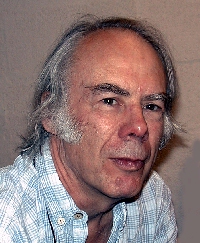
21 February 2006
Sir Nicholas Shackleton - In Memoriam
Edinbirgh, United Kingdom
With the recent death of
Sir Nicholas Shackleton, paleoclimatology lost one of its brightest
pioneers. Over the last ~40 years, Nick made numerous far-reaching
contributions to our understanding of how climates varied in the past, and
through those studies, he identified factors that are critically important
for climate variability in the future. His career neatly encompasses the
birth of the new science of paleoceanography to its synthesis into the even
newer science of 'Earth Systems'; he made major contributions to these
evolving fields throughout his life, and his insightful papers are required
reading for students of paleoclimatology.
Fundamentally, Nick was a geologist, with a research focus on changes
in ocean chemistry recorded in the marine sediments and the calcium
carbonate shells of tiny organisms (foraminifera) commonly found in them.
Nick was among the first to recognize that changes in the oxygen isotope
ratio(18O/16O) was not simply a function of
temperature, as had been previously thought, but rather a reflection of
global scale ocean chemistry which changed as ice built up on the continents
during glaciations. This resulted from the fractionation of oxygen isotopes
in water molecules, following evaporation from the ocean surface. As water
vapor is carried towards higher latitudes, and condensation occurs, the
precipitation that forms contains more of the heavy isotope (18O)
which is thus returned to the ocean, leaving the vapor isotopically lighter.
When precipitation forms as snow, and remains on the continents to form ice
sheets, the overall composition of the world ocean gradually changes,
becoming isotopically heavier (enriched in 18O) compared to
periods when there are no ice sheets on the continents.
Benthic foraminifera (those forams living in the deep ocean where
temperatures change very little) incorporated the isotopically heavier water
into their structure as they formed their shells. Thus, by measuring the
oxygen isotope ratios in benthic foraminifera, Shackleton effectively had a
measure of how much ice had accumulated on landa paleoglaciation index.
Furthermore, because the deep ocean composition is fairly well mixed,
benthic forams from all parts of the ocean recorded these changes more or
less synchronously. Thus, the variations could be used to correlate marine
records wherever they were recovered, providing a universal index of past
earth history. Variations in the oxygen isotopes gave rise to what are now
termed marine isotope stages; we are currently in isotope stage 1 (the
Holocene) and the last glaciation is represented by isotope stage 2 (when
the world ocean was more enriched in the heavy isotope). Notably, Shackleton
(1969) was the first to make the (correct) identification of 'isotope stage
5e' with the Eemian interglacial identified in land-based pollen records
(see figure). At that time (~125,000 years ago), the isotopic composition of
the ocean indicated there was even less ice on the continents than there is
today. This corresponded to higher sea-levels (~6m higher than today)
largely because the Greenland ice sheet was much diminished. (It is now
thought that there was a much smaller ice cap on the island at the peak of
the last interglacial; these changes were brought about by orbital
variations, whereas today there are concerns that higher levels of
greenhouse gases may have a similar result).
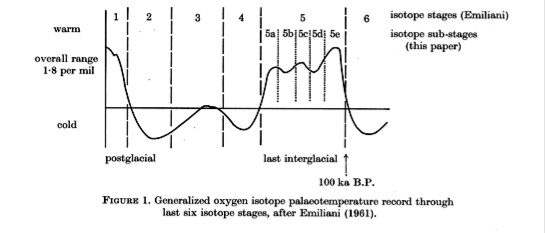
Figure 1 from Shackleton (1969) showing the breakdown of the last
120,000 years into isotopic 'stages'.
Earlier stages show the slowly evolving nature of glaciation (and the
intervening interglacials) on the earth. Nick teamed up with Neil Opdyke, a
paleomagnetist who was able to recognize (and date) reversals of the earths
magnetic field, to provide a timescale for these changes in oxygen isotopes,
and this provided a chronology that could then be used to understand the
frequency of glaciations and rates of change. Once a fairly reliable
timescale was established, it soon became apparent that there had been
regular sequences of glaciations and interglaciations that were related to
orbital forcing (changes in the earths position in relation to the sun, as
elaborated by Milankovitch). This was described in a landmark paper in
Science (1976) Variations in the earths orbit: pacemaker of the ice ages,
co-authored with colleagues Jim Hays and John Imbrie. From this many more
studies of orbital forcing, extending far back beyond the Quaternary period
also evolved from the marine oxygen isotope stratigraphy. In particular, the
CLIMAP (1981) project emerged, in which paleoceanographers mapped ocean
conditions at the height of the last glaciation, by identifying in each
sediment core the position where the isotopes in benthic forams were most
enriched (indicating maximum ice on the continents). While many of the
initial CLIMAP conclusions have been substantially revised, Shackleton's
isotope chronology remains as an essential tool in understanding earth
history.
Having identified a universal chronometer for continental glaciationnot
in the moraines and outwash deposits that provide the direct evidence of
former ice sheets, but far away in the deep ocean basinsresearchers were
then able to better understand the history of other terrestrial records,
such as the vast loess (wind-blown silt) deposits of China, and the emerging
ice core records from Antarctica and Greenland. Furthermore, since the
isotopic record in the oceans registered ice growth and decay on land, it
effectively provided a proxy for sea-level changes that could be checked
with sea-level terraces from areas where the land had risen (such as on the
Huon Peninsula of New Guinea, and in Barbados), preserving a record of past
sea-level changes in the coral reefs now exposed on land. By comparing the
reef-based sea-level history with the benthic foram-based record, Shackleton
(with colleagues John Chappell and others) was able to assess the extent to
which deep ocean temperatures may have changed over time, which would have
confounded the simple paleoglaciation index he originally formulated.
Shackleton subsequently argued that changes in glaciation could not be fully
explained by orbital forcing, and that feedbacks involving carbon dioxide
must have played a critical role, thereby highlighting the importance of
changes in the concentration of greenhouse gases in the atmosphere, in the
past and in the future.
Nick Shackletons research, arising from his original Ph.D. thesis on
isotopic variations of tiny marine organisms, had an enormous impact on
earth sciences. He had the insight to understand the implications of his
measurements and they literally transformed how we now view earth history.
For his discoveries he received many honors and awards. He was a Fellow of
the Royal Society, a Foreign Member of the U.S. Academy of Sciences, a
Fellow of the American Geophysical Union, and numerous other societies also
honored him. He was knighted for his services to science; with Willi
Dansgaard (who made similarly far-reaching studies of oxygen isotopes in
precipitation and applied these to ice cores) he received the Crafoord Prize
(considered as earth sciences Nobel Prize); he was also awarded Japans
Blue Planet Prize, the Milankovitch Medal, and most recently the Vetlesen
Prize.
Though he always considered himself, just a geologist, Nick had many
other talents, most notably in music. He was an
accomplished clarinet player and had a passionate interest in the history of
that instrument. He was considered a world expert for his knowledge of
antique clarinets and he had his own unique collection. At Cambridge
University, where he spent his entire career, Nick gave lectures on
Quaternary geology and paleoclimatology, but he also taught the physics of
music. Perhaps it was his knowledge of harmonics that played a critical role
in his understanding of orbital forcing and its impact on earth history. At
the tri-ennial ICP conference, Nick would always organise a Paleo-musicology
concert where the many musically talented scientists (and occasionally their
more-talented children) would entertain the rest of us. Nick was a true
Renaissance man and he leaves a very important legacy to both musicology and
the earth sciences. Besides all this, he was a nice guy and an inspiration
to all who came into contact with him.
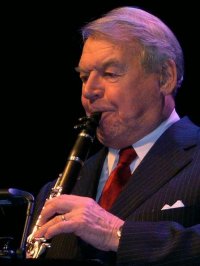
14 February 2006
In Memoriam - Hans Olof Wickman ( Putte
Wickman) Jazz Clarinet Legend in Sweden
Stockholm, Sweden
Hans Olof Wickman, better known as Putte Wickman, born September 10, 1924
in Falun Kristine Assembly, Falun, February 14, 2006 in Grycksbo, Falun
Municipality, was a Swedish musician and clarinetist, especially in jazz. He
was self-taught clarinet player, which did not prevent that he was regarded
as one of the best in the world.
Wickman grew up in Big Tuna outside Borlänge. After secondary studies in
Stockholm in 1944, he was a summer in Hasse Kahn orchestra. Later in the
1940s he started his own sextet, which played Benny Goodman-jazz but also
more modern music. This sextet was up to the mid-1960s.
In recent years, did Wickman, but are not believers, church concerts with
guitarist Goran Fristorp and pianist Jan Lundgren. In 2004 he participated
in the tribute show, A tribute to Putte, held on the occasion of his 80th
birthday, with, among others, Povel Ramel, Svante Thuresson, Jan Lundgren,
Anders Berglund's big band. In 2005 he appeared on the Jazz Festival in
Norrtälje, and on tour Wickman Wanner, together with Anders Berglund big
band with, among others, Sheeba, and Jill Johnson as a singer.
Putte Wickman was one of the
few in the world forward, who played jazz on the clarinet. His game can not
be compared with Benny Goodman or Artie Shaw, for he created his own way to
play the return to traditional modern jazz on. Had it not been for so had
Putte Wickman clarinet existence of jazz never really existed. Putte Wickman
is one of the greatest jazz clarinetist of all time and we will all remember
him in a very long time to come
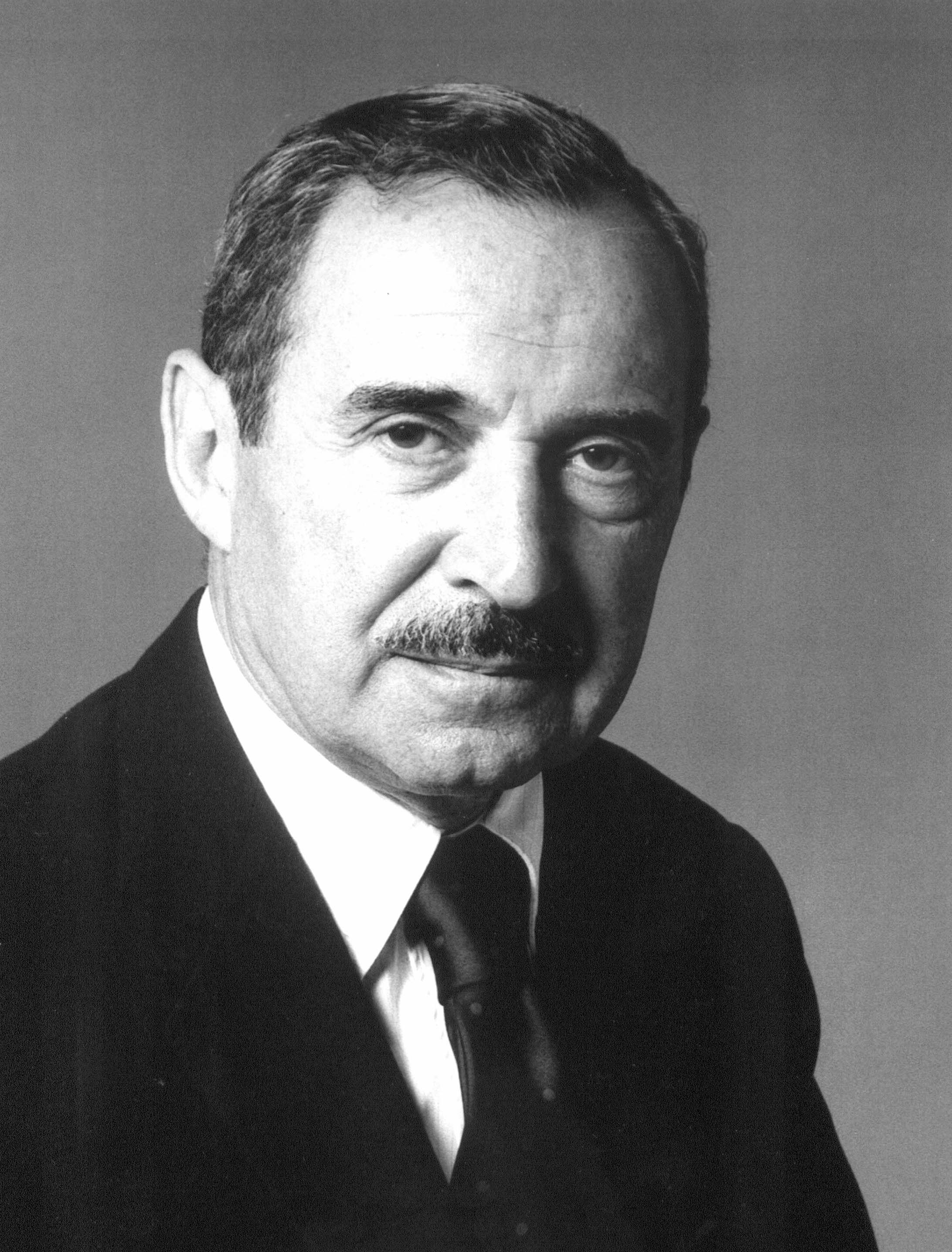
23 January 2006
David Weber In Memoriam
New York City USA
By DANIEL J. WAKIN
Published:
January 26, 2006
David Weber, a
clarinetist, who was one of the last remaining links to the pioneers of American
woodwind-playing and went on to become a master teacher, died on Monday at
Beth Israel Medical
Center in Manhattan. He was 92.
His son Michael Weber
announced the death. He had continued giving lessons until June.
Mr. Weber played for
conductors likeToscanini, Stokowski and Leinsdorf. His students occupy chairs in
orchestras around the country, including the
Milwaukee Symphony, the
Dallas Symphony and the Cleveland Orchestra. Benny Goodman took lessons (but
never paid and took his best reeds, Mr. Weber once said), and so did the jazz
clarinetist Kenny Davern.
But his most profound
influence may have been on the sound of the instrument.
Mr. Weber's great gift,
and his constant goal for students, was beauty of tone. His sound was full,
rich, resonant and pure.
"It had a unique bell-like
quality, that kind of clarity," said Jon Manasse, a soloist and principal
clarinetist of American Ballet Theater. "The resonance of the sound, when it was
correct, was enough to communicate the music without adding special effects or
gimmicks."
As recounted by Mr.
Manasse, Stokowski once called Mr. Weber over and said: "You, sir. Your tone,
it's like a dove cooing."
Mr. Weber himself, in an
article in The Clarinet, described good tone this way: "Think of colors: it's
got to be gold, silver, blue velvet. You have to reach out and touch it."
Mr. Weber was a dogmatic
teacher but deeply devoted to his students, and did not suffer fools gladly. He
had a reputation for being contentious, standing up to conductors and sometimes
alienating colleagues. He once argued with the conductor Bruno Walter, who tried
to make peace by giving an inscribed copy of his book about Mahler.
"I don't think it
succeeded," his son Michael said. "My father never spoke well of Bruno Walter in
my hearing." His survivors also include another son, Robert, and his wife,
Dorothy.
David Weber was born on
Dec. 18, 1913, in
Vilnius, Lithuania,
and moved with his family to Detroit. He took up the clarinet and studied with a
member of the Detroit Symphony. One day he arrived for a lesson and was sent
home; his teacher had committed suicide. The incident was searing, he told The
Clarinet.
He went to New York to
study with Simeon Bellison, the Russian principal clarinet of the New York
Philharmonic, who along with Daniel Bonade of France another Weber teacher
helped establish modern clarinet-playing in the United States.
In the late 1930's, he
auditioned for Toscanini and was immediately brought into the NBC Symphony. He
also had stints with the
New York Philharmonic,
Metropolitan Opera Orchestra, CBS Symphony and Symphony of the Air, the NBC
Symphony's successor. He was principal clarinet of the New York City Ballet
Orchestra from 1964 until 1986, when he retired from performance, and taught at
the Juilliard School.

8 December 2005
In Memoriam - Donald Martino, noted American composer
Newton, Massachusetts, USA
DONALD MARTINO (1931 -
2005) : Born in Plainfield, New Jersey, May 16, 1931, he began music lessons at
nine learning to play the clarinet, saxophone, and oboe and started
composing at 15. He holds degrees from Syracuse and Princeton Universities. A
member of the American Academy of Arts and Letters and a fellow of the American
Academy of Arts and Sciences, his many awards include two Fulbright
scholarships; three Guggenheim awards; grants from the Massachusetts Arts
Council, the National Institute of Arts and Letters, and the National Endowment
for the Arts; the Brandeis Creative Arts Citation in Music; the 1974 Pulitzer
Prize in music for his chamber work Notturno, First Prize in the 1985 Kennedy
Center Friedheim Competition for his String Quartet (1983), and most recently,
the Boston Symphony's Mark M. Horblit Award. Mr. Martino has taught at The Third
Street Music School Settlement in New York, Princeton, Yale, The New England
Conservatory of Music, where he was chairman of the composition department from
1969-1979, Brandeis, where he was Irving Fine Professor of Music, and Harvard,
where he is the Walter Bigelow Rosen Professor of Music, Emeritus. He has been
active as guest lecturer and has been Composer-in-Residence at Tanglewood, The
Composer's Conference, The Yale Summer School of Music and Art, The Pontino
Festival (It.), May in Miami, The Atlantic Center for the Arts, The Warebrook
Festival, The Ernest Bloch Festival, The Festival Internacional de Musica de
Morelia (Mex.), and has been Distinguished Visiting Professor at many
institutions of higher learning. Commissions for new works have come from,
among others, the Paderewski Fund; the Fromm, Naumburg, Koussevitzky, and
Coolidge Foundations; the Chicago, Boston, and San Francisco Symphonies; and a
number of musical societies and organizations. According to the New Grove,
"Martino's music has been characterized as expansive, dense, lucid, dramatic,
romantic, all of which are applicable. But it is his ability...to conjure up for
the listener a world of palpable presences and conceptions...that seems most
remarkable."
"Donald Martino, the Pulitzer Prize-winning American composer widely
respected for atonal works that combine intellectual rigor with
expressive freedom, died on Thursday aboard a cruise ship in the
Caribbean en route to Antigua. He was 74. During this trip, Mr Martino
was actively involved in composing a work for Violin and 14 Instruments
to the very day of his passing for the Tanglewood Music Center.
The cause was cardiac arrest following complications of diabetes, said
Lora Martino, his wife of 36 years, who was vacationing with him. Mr.
Martino lived in Newton, Mass.
A student of Roger Sessions and Milton Babbitt, he was an unapologetic
Modernist steeped in 12-tone techniques. His works, typically, were
dense and formidably complex. A skilled craftsman and comprehensive
musician, he believed in challenging listeners. In moments of
frustration, he attributed the difficulties his music had in winning
mainstream acceptance to concert promoters who cultivated a
"potty-trained audience," as he put it in an interview for his 60th
birthday.
For Clarinetists, he is well known for compositions such as his Set for
Solo Clarinet, and his Triple Clarinet Concerto, for Contemporary Ensemble.
His music publishing firm Dantalian, has a complete catalog of his works.
PUBLIC MEMORIAL and
TRIBUTE CONCERTS
 A
public memorial to celebrate the life and music of Mr. Martino will be held on
March 19, 2006 at 3:00
p.m. at Paine Hall, Harvard University. Selections of his music will be
performed, as will other pieces dear to the composer. Family, friends, and
colleagues will also speak briefly and share remembrances.
A
public memorial to celebrate the life and music of Mr. Martino will be held on
March 19, 2006 at 3:00
p.m. at Paine Hall, Harvard University. Selections of his music will be
performed, as will other pieces dear to the composer. Family, friends, and
colleagues will also speak briefly and share remembrances.
For directions and information on free
parking, visit Harvard University's
Paine Hall Directions website or email
loramartino@verizon.net.
Please Note:
In honor of Donald Martino, an annual award will be given to a composition
student at the
New England Conservatory, where Mr. Martino was chairman of the Composition
department from 1969 - 1981. Memorial donations to fund this award may be sent
to:
New England Conservatory
Attn: Regina
Tracy
Development Office
290 Huntington Ave.
Boston, MA 02115
Please indicate "for Donald Martino prize"
when sending donations. For more details, contact Regina Tracy at (617)
585-1138 or Jennifer Hill at (617) 585-1169.
|
|
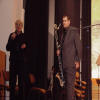
|
|
Josef Horak with Bass Clarinet colleague
|
|

|
|
Josef Horak, wife and Mike Getzin in Duesseldorf, Germany
|
|
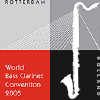
|
|
World Bass Clarinet Convention
|
|

|
|
Horak on Bass Clarinet
|
|
|
23 November 2005
In Memoriam Josef Horak
It is very sad to report the passing of this great pioneer of the Bass
Clarinet, who just had a Festival held in honor of his legacy in Rotterdam,
Holland this month. This Convention honored the 50th Anniversary of a Bass
Clarinet Recital held at the beginning of this era. More information below about
Horak's illustrious solo career and his influence on the entire Bass Clarinet
world.
In March 1955, Josef Horák performed the world's first solo bass clarinet
recital.
To celebrate the 50th anniversary of this great occasion the newly
founded World Bass Clarinet Foundation held a 3 day bass clarinet convention
from 21st-23rd October 2005 - the first event ever to
focus solely on all aspects of bass clarinet performance.
Historical
Event
On 23rd March 1955
the Czech bass clarinettist, Josef Horák, performed the first ever solo bass
clarinet recital. This recital marked a turning point for the bass clarinet and
provided me with the inspiration to organize the first World Bass Clarinet
Convention in the 50th anniversary year. - Henri Bok
|
The DUE BOEMI DI PRAGA was founded in 1963.
It is the only ensemble of that kind that has systematically
concentrated on the interpretations of music ranging from the
Renaissance up to the present times. By this art activity the two
Czech outstanding musicians have provoked a completly new sphere of
music literature which has not existed up to their time.
Leading world composers, as e.g. Paul Hindemith, Bohuslav Martinů,
Olivier Messiaen, Karlheinz Stockhausen, Frank Martin, Klaus Huber,
Henri Pousseur, Kazuo Fukushima, Pablo Casals or Alois Hába
dedicated or authorised their compositions to DUE BOEMI DI PRAGA.
In 1955, Josef Horák revealed to musicians and audiences who
uplifted this instrument from the orchestral ranks to the level of a
solo instrument. Its soft singing tone has become a new sound ideal
of the bass clarinet. The new starting and breathing technique has
broadened its extent, its dynamic scale as well as possibilities of
expression and technique. Horák has influenced the developmend of
the bass clarinet playing in the world by this decisive way.
Therefore world critics call him "Paganini of the bass clarinet".
His first evening concert in 1955 was at the same time the first
bass clarinet recital in the history of music. |
|
|
UNESCO - March 1988 - International Kolloquium
Festival Leo Janáček - Paris
|
Due Boemi made radio
recordings for 42 radio studios in Europe and overseas.
Due Boemi played concerts on 4 continents. |
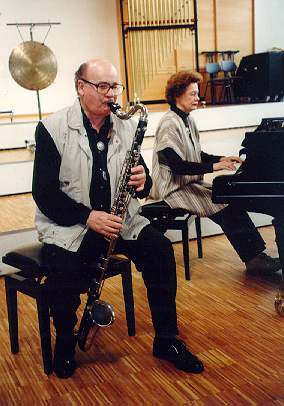 |
|
We can find in the
repertoire of the Due Boemi also newly discovered music from the
Renaissance period (suites of dances and songs by anonymous
composers of the 15th, 16th and 17th century), barocs
sonatas for a deep melody instrument and basso continuo (like Händel,
Telemann, Purcell, Marcello and others). In addition, seldom heared
classic a romantic pieces of Mozart, Beethoven, Dvořák,
Smetana, Schumann, and indeed, there are great many for the Due
Boemi di Praga specially composed, dedicated ot authorized
contemporary opus of different styles.
|
|
| |
22 June 2005
In Memoriam David Breeden
- Solo Clarinetist with San Francisco Symphony
San
Mateo, California USA
David Breeden, 58, Solo
Clarinetist in the San Francisco Symphony, died June 22 of complications from
multiple myeloma at a care center in San Mateo, California.
Mr. Breeden is the son of
Leon Breeden, the former Grand Prairie High School band director who went on to
be the longtime head of jazz studies at what is now the University of North
Texas.
David Breeden was born in
Fort Worth. He and his family later lived in Grand Prairie and Denton as his
father's career progressed. David Breeden followed in his father's footsteps to
play the clarinet. The retired professor said his son was a natural.
When David was in fourth
grade, he heard his father practicing and told him he liked the sound. Mr.
Breeden told his son that he would give him a clarinet if he learned to play. He
heard his answer six weeks later.
"I walked in our little house
there in Grand Prairie one afternoon after band rehearsal, and I heard
'Stardust' going in the front room," Mr. Breeden said. "I said, 'David, that
horn is yours.' "
David Breeden received
degrees from North Texas State University, now UNT, and Catholic University. He
performed for several years with the Navy Band before joining the San Francisco
Symphony in 1972.
17 February 2005
Munich, Germany - In memoriam
Marcello Viotti
|
|
| |
| |
|
|
|
|
|
|
|
|
Marcello Viotti, an Italian conductor with
strong Swiss roots (www.marcello-viotti.com)
|
|
|
|
Swiss-born
conductor Marcello Viotti, musical director of Venices La
Fenice Theatre, has died at the age of 50.
Viotti conducted
renowned orchestras, including the Berlin Philharmonic, New
Yorks Metropolitan Opera and the English Chamber Orchestra,
and performed at opera houses around the world. |
|
|
|
|
|
|
|
|
|
Viotti died on
Wednesday in a Munich hospital after suffering a stroke last
week.
Born to Italian immigrants in western Switzerland in 1954,
Viotti studied the piano, cello and singing at the Lausanne
Conservatory. He made his conducting debut in nearby Geneva with
a wind ensemble that he founded in 1974.
In 1982 he won first prize at a renowned conducting competition
in Italy, which launched his international career.
He rose to prominence as chief conductor of the Turin Opera.
Viotti served as artistic director of the Lucerne Theatre in
Switzerland and conducted orchestras in several German cities.
Last year he quit his position as conductor in Munich in protest
at plans to shut down the orchestra in 2006. Viotti had notably
directed a successful concert cycle with Munichs Radio
Orchestra, entitled Paradisi Gloria, devoted to
20th-century choral music.
Venice, New York,
Vienna
At Venices La
Fenice Theatre, where he had been musical director since 2002,
Viotti won acclaim for his production of Jules Massenets
Thais.
Other productions included Giuseppe Verdis La Traviata
and Richard Strausss Ariadne auf Naxos.
Viotti made his debut at the Met in New York in 2000 with
Giacomo Puccinis Madame Butterfly. He later returned
for La Bohème and La Traviata.
He gave his last public performance on February 5, when he
conducted Vincenzo Bellinis Norma at the Vienna State
Opera.
Viotti was due to conduct new productions in Venice, Salzburg
and Zurich later this year.
The world of music praised Viotti as a leading light of his
generation.
"He will live on not only because of his high professional
standard and his musical talents, but also his warm personality
and generosity," said Alexander Pereira, director of Zurichs
Opera House. |
|
|
|
|
|
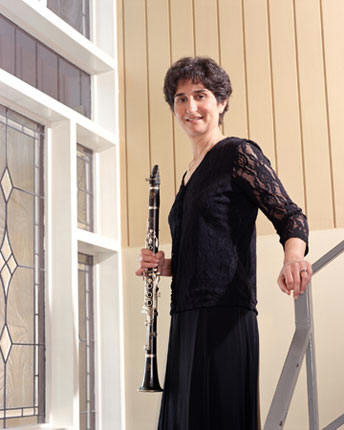
Portrait
by Donna Granata
Emily Bernstein
in Memoriam (1959 - 2005)
At the time of her death, Emily Bernstein was the principal clarinetist of the
Los Angeles Opera. She also played first chair with the Pasadena Symphony under
the direction of Jorge Mester. She was a member of the acclaimed contemporary
music ensemble, XTET, which has presented numerous world premieres. She
performed with many southern California ensembles including the Angeles String
Quartet, and the Pacific Trio. She enjoyed many happy summer seasons in
Jacksonville, Oregon as principal clarinetist with the Peter Britt Music and
Arts Festival. In addition to her busy performing career, Emily maintained an
active private teaching studio and was affiliated with the Mancini Institute.
Ms.
Bernstein graduated with honors from Stanford University and earned a Master of
Music degree from the Eastman School of Music.
Ms.
Bernstein made frequent appearances as a soloist and chamber musician throughout
the west and recorded for the Delos, Phillips, and Sony Classics labels. She was
an active studio musician and has performed on hundreds of motion picture and
television scores including, Catch Me If You Can, Pirates of the Caribbean, Sea
Biscuit, and JAG. She was featured in the John Williams score for the movie The
Terminal. An article in the La Cañada Valley Sun reported that after Emily
recorded the clarinet solo for "The Terminal," director Steven Spielberg - a
former clarinetist himself - insisted that Bernstein's name appear in the film's
end credits, although traditionally individual musicians performing in studio
orchestras remain anonymous.
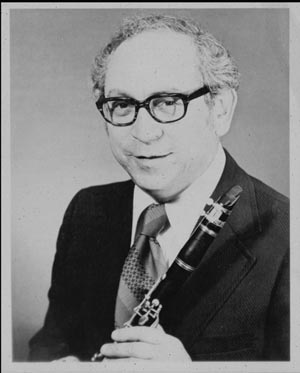
2 January 2005
Raleigh, North Carolina USA - Herbert Blayman - in Memoriam
The Clarinet world lost a hallmark Clarinetist and teacher in Mr Blayman, an
established artist-teacher and celebrated Solo Clarinetist in the Metropolitan
Opera Orchestra at Lincoln Center in New York. As a pedagogue, he taught
at the Manhattan School of Music and other schools in New York and has been
responsible for the effective mentorship of students who have achieved major
successes in the music performance field. Since retiring from the Orchestra, he
has pursued Clarinet mouthpiece making with an incredible quality control played
by many professionals around the USA. Blayman stands as one of the rare
teachers who have left a benchmark to be emulated in this generation.
30 December 2004
Artie Shaw in Memoriam
|
The
following biography was written in September of 1995. Artie Shaw was 94. |
|
On
the eve of America's entry into World War II, TIME magazine reported that to
the German masses the United States meant "sky-scrapers, Clark Gable, and
Artie Shaw." Some 42 years after that, in December l983, Artie Shaw made a
brief return to the bandstand, after thirty years away from music, not to
play his world-famous clarinet but to launch his latest (and still touring)
orchestra at the newly refurbished Glen Island Casino in New Rochelle, New
York.
Oddly
enough, New Rochelle isn't all that far from New Haven, Connecticut, where
Artie Shaw spent his formative years and at an early age became a compulsive
reader, and where at 14 he began to play the saxophone (and several months
later the clarinet), and at 15 left home to play all over America, and
meanwhile study the work of his early jazz idols, such as Bix Beiderbecke,
Frank Trumbauer, and Louis Armstrong. |
|
|
At the age of 16 Artie
went to Cleveland, where he remained for three years, the last two working
with Austin Wylie, then Cleveland's top band leader, for whom Shaw took over
all the arranging and rehearsing chores. In 1927 Artie heard several "race"
records, the kind then being made solely for distribution in black (or
"colored," as they were then known) districts. After listening entranced to
Louis Armstrong and his Hot Five playing Savoy Blues, West End
Blues, and other now-classic Louis Armstrong records from the late
1920's, Artie made a pilgrimage to Chicago's Savoy Ballroom to hear the
great trumpet player in person. Back in Cleveland, Artie, now 17, won an
essay-writing contest which took him out to Hollywood in 1928, where he ran
into a couple of musicians he had known back in New Haven who were now
working in Irving Aaronson's band. A year later, at the age of 19, Artie
moved to Hollywood to join the Aaronson band.
Shortly
afterwards, the Aaronson band spent the summer of 1930 in Chicago, where
Artie "discovered a whole new world" (as he would much later write, in a
semi-autobiographical book The Trouble With Cinderella first
published in 1952) when he heard several recordings of some of the then
avant-garde symphonic composers' work: Stravinsky, Debussy, Bartok, Ravel,
et al, whose work would eventually influence most of our contemporary jazz
performers. This influence would soon surface in Shaw's own work when he
began to use strings, woodwinds, etc. -- notably in a highly unusual album
entitled Modern Music for Clarinet, selections of which were also
featured in several of Shaw's Carnegie Hall concerts.
When
the Aaronson band came to New York in 1930, Artie decided to stay there, and
within the year, at age 21, he became the top lead-alto sax and clarinet
player in the New York radio and recording studios. After a couple of years
of commercial work, he became disillusioned with the music business and
bought some acreage with an old farmhouse in Bucks County, Pennsylvania. He
moved out there to spend the next year chopping wood for a living and trying
to train himself as a writer -- of books rather than music -- since there
seemed to be no way at that time to make a decent living playing the kind of
music that interested him.
In
1934 he returned to New York to pick up his formal education where it had
been abruptly terminated when he left high school at 15, and resumed studio
work to support himself. He made his first public appearance as a leader in
1936, in a Swing Concert (history's first) held at Broadway's Imperial
Theatre. This proved to be a major turning point in his career, and would in
fact ultimately have a significant impact on the future of American Big Band
jazz. Shaw (who was then completely unknown to the general public) did
something totally unorthodox to fill one of the three minute interludes in
front of the stage curtain while such then established headliners as Tommy
Dorsey, the Bob Crosby Band, the Casa Loma Band, etc. were being set up.
Instead of the usual jazz group (a rhythm section fronted by a soloist),
Shaw composed a piece of music for an octet consisting of a legitimate
string quartet, a rhythm section (without piano), and himself on clarinet --
an extremely innovative combination of instruments at that time. Fronting
this unusual group, he played a piece he had written expressly for the
occasion, Interlude in B-flat, which the group presented to a totally
unprepared and, as it turned out, wildly enthusiastic audience. (This, by
the way, is the first example of what has now come to be labeled "Third
Stream Music.")
Shaw
could scarcely have known that within a short time he would make a hit
record of a song called Begin the Beguine, which he now jokingly
refers to as "a nice little tune from one of Cole Porter's very few flop
shows." Shortly before that he had hired Billie Holiday as his band vocalist
(the first white band leader to employ a black female singer as a full-time
member of his band), and within a year after the release of Beguine, the
Artie Shaw Orchestra was earning as much as $60,000 weekly -- a figure that
would nowadays amount to more than $600,000 a week!
The
breakthrough hit record catapulted him into the ranks of top band leaders
and he was immediately dubbed the new "King of Swing". Today, Shaw's
recording of Begin the Beguine sells thousands and has become one of
the best-selling records in history.
Superstardom
turned out to be a status that Shaw (as a compulsive perfectionist) found
totally uncongenial. Within a year he abruptly took off for another respite
from the music business, this time in Mexico. In March of 1940 he re-emerged
with a recording of Frenesi, which became another smash hit. For this
recording session, he used a large studio band with woodwinds, French horns,
and a full string section along with the normal dance band instrumentation
-- another first in big band jazz history. Later that year he formed a
touring band with a good-sized string section, with which he recorded
several more smash hits, among them his by now classic version of Star
Dust, plus a number of other fine musical recordings such as Moonglow,
Dancing in the Dark, Concerto for Clarinet, and many others.
Shortly
after the bombing of Pearl Harbor, the unpredictable Shaw quit the music
business once again, this time to enlist in the U.S. Navy. After finishing
boot training, he was asked to form a service band which eventually won the
national Esquire poll. He spent the next year and a half taking his music
into the forward Pacific war zones, playing as many as four concerts a day
throughout the entire Southwest Pacific, on battleships, aircraft carriers,
and repair ships, ending with tours of Army, Navy, and Marine bases (and
even a number of ANZAC ones when his band arrived in New Zealand and
Australia). On returning to the U.S. -- after having undergone several
near-miss bombing raids in Guadalcanal -- physically exhausted and
emotionally depleted, he was given a medical discharge from the Navy. His
troubled marriage to Betty Kern (the daughter of composer Jerome Kern) ended
in divorce, and in 1944 Shaw formed another civilian band -- featuring such
great performers as pianist Dodo Marmarosa, guitarist Barney Kessel, and the
phenomenal trumpeter Roy Eldridge -- with which he toured the country and
made many excellent recordings.
In
1947, during another hiatus, Shaw spent about a year in New York City in an
intensive study of the relation of the clarinet to non-jazz (or, as he
prefers to call it, "long-form") music. This culminated in a tour in 1949 of
some of the finest musical organizations in America, such as the Rochester
Symphony Orchestra under the direction of Eric Leinsdorf, the National
Symphony in Washington, D.C., the Dayton Symphony, three appearances with
New York's "Little Orchestra" (one in Newark, a second in Brooklyn's Academy of
Music, and the last in Town Hall). After that Shaw recorded the
aforementioned Modern Music for Clarinet album, containing a
collection of remarkably well crafted symphonic orchestrations of short
works by Shostakovich, Debussy, Ravel, Milhaud, Poulenc, Kabalevsky,
Granados, Gould, along with Cole Porter and George Gershwin. About that time
Shaw again appeared in Carnegie Hall, as guest soloist with the National
Youth Orchestra conducted by Leon Barzin, where he received critical acclaim
for his rendition of Nicolai Berezowski's formidable Concerto for
Clarinet, which he had previously presented in its world premiere a few
weeks earlier with the Denver Symphony. Around that time he performed the
Mozart Clarinet Concerto with the New York Philharmonic conducted by
Leonard Bernstein at a benefit performance, held at Ebbetts Field, for
Israel's Philharmonic Orchestra.
During that year, Shaw also played numerous chamber music recitals with
string quartets, at various colleges and universities around the country.
Another
of Shaw's ventures during that period was his great 1949 band, which was
virtually ignored by the general public until 1989, when an album of some of
its work was released on compact discs by MusicMasters, and has since
received remarkable worldwide reviews.
In
1951 Shaw again quit the music business, this time moving to Duchess County,
New York, where he bought a 240 acre dairy farm and wrote his first book, a
semi-autobiographical work entitled The Trouble With Cinderella: An
Outline of Identity, sections of which have appeared in many
anthologies, and which is still in print.
Throughout
the early fifties, Artie Shaw assembled several big bands and small combos
-- as well as his own symphony orchestra, (to play a one-week engagement at
the opening of a large New York jazz club called Bop City). One such combo which
was formed in late 1953 and recorded in 1954, a group known as the Gramercy
5 (a name he took from the New York telephone exchange of the time),
maintain an amazingly high degree of popularity to this day despite the
onslaught of Rock, MTV, and other such commercial phenomena.
In
1954 Artie Shaw made his last public appearance as an instrumentalist when
he put together a new Gramercy 5 made up of such superb modern musicians as
pianist Hank Jones, guitarist Tal Farlow, bassist Tommy Potter, et al. The
most comprehensive sampling of that group (as well as a number of others,
going all the way back to 1936 and on up through this final set of records)
can be heard on a four record album, now a rare item, released in 1984 by
Book of the Month Records, entitled: Artie Shaw: A Legacy, which has
also received rave reviews. Some of this music was re-issued on two double
CD's by MusicMasters as Artie Shaw: The Last Recordings, Rare and
Unreleased, and Artie Shaw: More Last Record�ings, The Final Sessions.
Artie
Shaw packed his clarinet away once and for all in 1954. In 1955 he left the
United States and built a spectacular house on the brow of a mountain on the
coast of Northeast Spain, where he lived for five years. On his return to
America in 1960 he settled in a small town named Lakeville, in northwestern
Connecticut, where he continued his writing, and in 1964 finished a second
book (consisting of three novellas) entitled I Love You, I Hate You, Drop
Dead! In 1973, he moved back to California again, finally ending up in
1978 in Newbury Park, a small town about 40 miles west of Los Angeles,
situated in what he refers to as "Southern California pickup-truck country."
Since
then, aside from a brief venture into film distribution (1954 to 1956), and
a number of appearances on television and radio talk shows, Artie Shaw has
had very little to do with music or show business. He still gives occasional
interviews on television, radio, and newspapers and lectures all over the
United States. He still conducts seminars on literature, art, and the
evolution of what is now known as the Big Band Era. He has given lectures at
Yale University, the University of
Pennsylvania, the University
of Southern California, the
University of California at Santa Barbara,
the California State University at Northridge, and Memphis State University.
He has received Honorary Doctorates at California Lutheran University and
the University of Arizona. His home contains a library of more than 15,000 volumes, including a
large collection of reference works on a wide variety of subjects ranging
from Anthropology to Zen.
Artie
Shaw has been a nationally ranked precision marksman, an expert
fly-fisherman, and for the past two decades has been working on the first
volume of a fictional trilogy, dealing with the life of a young jazz
musician of the 1920's and 30's whose story he hopes to take on up into the
1960's.
Shaw's
own life is the subject of a fine feature-length documentary by a Canadian
film-maker. Artie Shaw: Time Is All You've Got is a painstakingly
thorough examination of Shaw as he is today and as the leader of some of his
great bands, including an appearance from one of his two earlier motion
pictures, Second Chorus (1940). (Scenes from his other motion
picture, Dancing Coed (1939), were not included in the documentary
due to prohibitive cost.) In a review of the film at Los Angeles's Filmex
Film Festival in the summer of 1985, Variety commented: "A riveting
look back at both the big band era and one of its burning lights." The film
has received glowing reviews wherever it has been shown -- Los Angeles,
Santa Barbara, Minneapolis, Toronto, Boston, and on Cinemax -- as well as in
England, where it ran twice on BBC. It has also appeared at Film Festivals
in Belgium, Switzerland, Australia, and Spain (where it took first prize in
the documentary category). In 1986 it opened the San Francisco Film
Festival, and in 1987 the Academy of
Motion Picture Arts and
Sciences awarded it the Oscar for Best Documentary Feature of 1986.
On
first meeting Artie Shaw, young Wynton Marsalis remarked, "This man's got
some history." Shaw is regarded by many as the finest and most
innovative of all jazz clarinetists, a leader of several of the greatest
musical aggregations ever assembled, and one of the most adventurous and
accomplished figures in American music.
As
Artie Shaw goes on into his nineties, he has also developed a crusty humor,
as evidenced by an epitaph for himself he wrote for Who's Who in America a
few years ago at the request of the editors: "He did the best he could with
the material at hand." However, at a recent lecture to the music students of
the University of Southern California, when
someone mentioned having read it, Shaw said, "Yeah, but I've been thinking
it over and I've decided it ought to be shorter, to make it more elegant."
And after a brief pause, "I've cut it down to two words: 'Go away.'"
|
|
|
7 December 2004
Siesta, Florida USA - In Memoriam Frederick Fennell
|
In Memoriam
Maestro Frederick
Fennell
Principal Guest Conductor, Dallas
Wind Symphony
July 2, 1914
- December 7, 2004
Dr. Frederick Fennell passed
away peacefully at his home in Florida on December 7.
The maestro served as
Principal Guest Conductor of the
Dallas Wind Symphony
for many years and we are profoundly saddened by
this loss. The band world has
truly lost one of its greatest. Our prayers go out
to him and his family.
Home -
People |
|
Dr. Frederick
Fennell is one of the world's most active and innovative maestros.
This globe-trotting nonagenarian is principal guest conductor of the
Dallas Wind Symphony, principal conductor of the Tokyo Kosei Wind
Orchestra in Japan, and Professor Emeritus at the University of
Miami School of Music.
The
internationally-acclaimed conductor is widely regarded as the leader
of the wind ensemble movement in this country, is one of America's
most recording living American classical conductors, and is a
pioneer in various methods of recording.
While
maintaining obvious devotion to the band and its music, he has
pursued such illustrious and wide ranging activities as conductor of
orchestra, opera, and popular repertoire. He has made guest
conducting appearances with symphony orchestras and bands all over
the world, is a member of many organizations, and has won numerous
awards.
Born July 2, 1914 in Cleveland,
Ohio, the maestro studied at the Eastman School of Music on the
University of Rochestrer campus, earning a Bachelor of Music degree
in 1937 and a Master of Music degree two years later. He became a
member of the Eastman conducting faculty in 1939, founded the
Eastman Wind Ensemble in 1952, and received an Honorary Doctorate
from Eastman in 1988.
High-fidelity
and stereo performances on 22 albums for Mercury Records grant him a
unique position in the annals of the recording art. He was conductor
of the Cleveland Symphonic Winds when he made the first symphonic
digital recording in the United States for Telarc Records in 1978.
The maestro also pioneered high definition compatible digital (HDCD)
recordings with the Dallas Wind Symphony. The maestro has also
recorded for CBS-Sony, Nippon-Columbia, King and Kosei labels.
Dr. Fennell has
served as conductor of the Columbia University American Festival,
the National Music Camp, the Yaddo Music Period, the
Eastman-Rochester Pops Orchestra and the Eastman Opera Theatre,
among others.
He has been
principal guest condluctor of the Interlochen Arts Academy, and
other guest conducting stints include frequent appearances with the
Boston Pops Orchestra as well as performances with the Carnegie Hall
Pops Concerts and the Boston Esplanade concerts. He has appeared
with the Denver, San Diego, National, Hartford, St. Louis and London
Symphonies; the Buffalo, Calgary and Greater Miami Philharmonic
Orchestras, the Cleveland Orchestra and the New Orleans
Philharmonic.
He was also
previously Musical Director of the School Orchestra of America with
which he toured Europe in the mid '60s.
Through the years, Dr. Fennell has risen to legendary
stature in the world of music and this is reflected in the honors
bestowed upon him. These include an Honorary Doctor of Music degree
from
Oklahoma City University, membership in the Society of the Sons of
the American Revolution, honorary chief status in the Kiowa tribe,
and a fellow in the Company of Military Historians.
In 1961, he
received a citation and a medal from the Congressional Committe for
the Centennial of the Civil War for two volumes of recordings of the
Music of the Civil War.
Also, he was the
recipient of the 25th Anniversary of Columbia University Ditson
Conductor's Award in April of 1969, and of the New England
Conservatory's Symphonic Wind Ensemble Citation in 1970. He was also
awarded the Mercury Record Corporation Gold Record in 1970, and the
National Academy of Wind and Percussion Arts Oscar for outstanding
service as a conductor in 1975.
The
Fennell/Eastman Wind Ensemble recording of Percy Grainger's
Linconshire Posy was selected as one of the Fifty Best Recordings of
the Centenary of the Phonograph, 1877-1977, by the Stereo Review. In
1977, he was named consultant to the Scala Memorial Fund Library of
Congress. That same year, he received the Eastman School of Music
Alumni Citation for the 25th Anniversary of the founding of the
Eastman Wind Ensemble.
He received the
University of Rochester Outstanding Alumni Award in 1981, and the Kappa Kappa Psi Distinguished Service
Medal in 1982.
He was presented
the Star of the Order in 1985 from the John Philip Sousa Memorial
Foundation.
Other
distinctions include the Interlochen Medal of Honor and the Midwest
International Band and Orchestra Clinic Medal of Honor, awarrded in
1989. The following year, Dr. Fennell was inducted into the National
Bandmasters Association Hall of Fame for Distiguished Band
Conductors. In January of 1994, he received the Theodore Thomas
Award presented by the Conductors Guild, Inc., in recognition of
unparalleled leadership and service to windband performance
throughout the world. The last two recipients of this award were
maestros Solti and Bernstein.
He was the
initial recipient of the Medal of the International Percy Grainger
Society for Distinguished Services in 1991.
Frederick
Fennell Hall was dedicated in Kofu, Japan,
with a concert by the Tokyo Kosei Wind Orchestra on July 17, 1992.
Dr. Fennell has
authored several publications with musical topics, including his
1954 book Time and the Winds, which is still the only text of its
kind. He is also the author of the continuing series The Basic Band
Repertory Study/Performance Essays, editor of contemporary editions
of classic military, circus and concert marches for Theodore Presser
Co., Carl Fisher, Inc., Sam Fox Publishing Co., Boosey & Hawkes,
Inc., and of the Fennell Editions for Ludwig Music. |
|
| |
| |
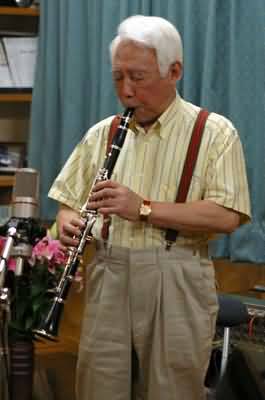
30 June 2004
Risei Kitazume (1919-2004) - In
Memoriam -
Tokyo, Japan
Risei Kitazume, past president of Japan Clarinet Society from 1980 to
1986, died of pancreatic cancer on June 30, 2004. HI is survived by his wife
Waki, his parents and his children, Michio and Yayoi both of them are composers.
Mr. Kitazume was born in the mid of Tokyo on April 16, 1916 and started
playing trumpet in 1929 when he entered Sijyo junior high school. In 1934, he
began to play clarinet at Seijyo High School under the instruction of Mr. Tomio
Tsujii and Mr. Tetsuo Yamamura. He received his undergraduate degree of music
from Tokyo Music School (now called Tokyo National University of Fine Arts and
Music) in 1941. His mentor was Mr. Hironori Nakayama. He was awarded Koda grant.
He served military from February 1942 to August and he resigned because of his
health. After returning from military service he completed his graduate school
and assigned as a part-time lecture of the school. In the same year, he married
with his wife. In 1942 he joined Tokyo Broadcasting Symphony Orchestra and from
1945 he again served military till the end of the World War II. In 1946 he moved
to Tokyo Philharmonic and also assigned as an associate professor of Tokyo
National University of Fine Arts and Music. In 1947 he moved to Toho
Philharmonic (now called as Tokyo Symphony Orchestra). He also played with
Eolian Club with Hidemaro Konoe. From 1955, he was assigned as an associate
professor of Toho Gakuen and then a full professor and he received an honorary
professor in 1997 and also he taught several schools including Yamagata
University, Senzoku Gakuen, Nihon University, Soai Gakuen, and so on. Beside
those teaching careers, in 1965 he introduced the Krommer Clarinet Concerto #1
and played with Tokyo Symphony Orchestra and Mr. Kazuyoshi Akiyama as a
conductor, and Olivier Messiaen's Quatuor Pour La Fin Du Temps (Quartet For The
End Of Time) in 1967.
Mr. Kitazume gave much to this society through his teaching and performing
and we regret that he did not have more time among us.
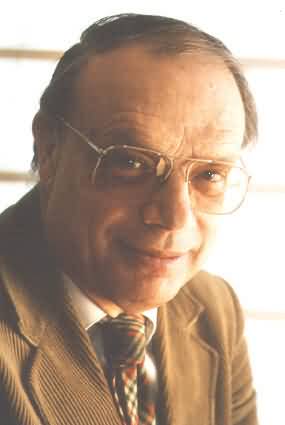
29 June 2004
Jost Michaels - in Memoriam
Detmold,
Germany
|
Jost Michaels, clarinetist, pianist, conductor, writer and arranger
died on June 21st at the age of 82, after a long illness. I had the
privilege of studying with Prof. Michaels in Detmold from 1980 to 1983
and worked with him subsequently on the Boehm-System version of his
legendary Systematic of Clarinet Fingering Technique. He was one of
the few musicians I have ever met. He played piano and
clarinet and was one of the only people ever to receive a double
professorship in both instruments in Germany. He recorded extensively
on both instruments, published many articles on musical subjects and
arranged numerous works for clarinet. He was also quite proficient on
the violin.
Professor
Michaels was uncompromising in his desire to bring out the best of
every piece he played. He was a champion of unknown composers and
their works, believing that one cannot understand the greatness of
masterpieces if one does not have a thorough knowledge of the other
works of their time, and of the composers who, from our point of view,
stand almost hidden in the shadows of the masters.
Jost Michael's students
sit in major international orchestras and teach at institutions all
over the world. He taught in a way that went far beyond instruction in
tone and technique. He taught each student to use their own sound and
abilities to get to the heart of a compositionâs musical character,
and to be able to lead listeners to understand the intensity,
structure and special character of each piece. He was insistent on
players knowing the whole piece, and not just the clarinet part, on
their knowing as many other pieces by the same composer - and all his
or her contemporaries! - as possible. I have seen him practically
throw students out of lessons if they didnÌt know if a composer had
written Lieder (Art Songs) or not. A prerequisite for any lesson was
knowing the piano part inside and out, as he accompanied all lessons
himself and had little patience for wrong tones or entrances...I think
you better take another look at this, Herr .....!
At the end of his teaching career he
packed the clarinet away and dedicated himself more to piano and even
more to research and writing. Near the end of his life he published
two works of importance. The Dilemma in Modern Musical Education,
about the need for restructuring musical education to meet purely
artistic needs, and to increase the students ability to interpret
unknown (unrecorded) works. His last work was a major treatise on
Brahms use of the clarinet, asserting and evaluating Brahms
relationship to the clarinet before his friendship with Muhlfeld.
I will miss Jost
Michaels. He demonstrated what it is like to be totally immersed with
mind and spirit in what one is playing. He was also a window into
another epoch of music-making, if you will, having studied with
masters from the 19th century, and being a product of early 20th
century ideas. The most modern-day musician still has a need for
hearing âold-timeâ ideas to be truly equipped for the music at
hand. For me, and many other of his students, the intensity of Jost
Michaels music-making and teaching awakened that part of me
which could play the best.
Allan Ware |
|
June 2004
John LaPorta -
in Memoriam
New York City USA
John LaPorta (1920-2004) was classically trained in part at the Manhattan School
of Music and joined the Bob Chester band in 1940 to play lead clarinet. He
worked with Ray McKinley and Woody Herman as an alto saxophonist and composer.
He took over Buddy DeFranco's spot with the Metronome All-Stars in 1951 (as a
clarinetist) and was a founding member of the Jazz Composer's Workshop (with
Charles Mingus and Teo Macero) in 1953. He recorded extensively with Mingus,
the JCW, and Lennie Tristano in the 1950s on both sax and clarinet. He wrote
articles for Downbeat magazine including "Up Beat Section: Clinician's Corner"
about learning to play jazz in 1960. He also recorded under his own name on
the albums "John LaPorta", "Conceptions", "Clarinet Artistry", and "Most
Minor". He was a jazz educator starting in the 1950s and served on the faculty
at the Manhattan School of Music (1959-1980s). His playing and arranging was
widely respected by modern jazz players in the 1950s and 1960s and helped found
jazz education.
|
|

|
|
Stanley Drucker with Jean and David Hite on mouthpieces
|
|

|
|
Drucker- Hite mouthpiece tryouts
|
|

|
|
Stanley Drucker with Hite mouthpiece check
|
|

|
|
Hite Mouthpiece session
|
|
|
18 January 2004
David Hite - in Memoriam
Estero, Florida USA
David Hite, age 80, a resident
of Estero FL, died Sunday, January 18, 2004 at Hope Hospice, Ft. Myers FL. He
had been taken ill suddenly four weeks earlier. Born Sept. 25, 1923 in New
Straitsville OH, he devoted his life to the study and mastery of the clarinet.
He studied with Fred Weaver of Columbus, Daniel Bonade of New York, and Anthony
Gigliotti of Philadelphia. After moving with his family to Columbus in 1941, he
enrolled in the Ohio State University School of Music where he subsequently
earned Bachelor and Master of Arts Degrees in Music. During WWII he joined the
US Army, serving in Guam and Okinawa as a band musician. Upon discharge, he
returned to play in the Columbus Philharmonic Orchestra and in the Berkshire
Music Festival Orchestra at Tanglewood MA. In 1954 he joined the music faculty
of Capital University where he taught for over 20 years. In 1980, he joined in
collaboration and support of the Klar/Fest 81 at Catholic University and was
instrumental in the success of this Festival and several subsequent Clar/Fests
in Washington and Towson State Universities. ClariNetwork International
was organized at this time after the artistic success of the Klar/Fest.
After leaving Columbus in 1983, he moved to the New York City area, working with
artist clarinet and saxophone players in custom servicing instruments and
mouthpieces. In 1986 he settled in Florida where, with his wife Jean, he won
international recognition for the design and production of
J & D Hite clarinet
and saxophone mouthpieces. He also worked to expand the clarinet music
literature, publishing many new editions and arrangements with Southern Music
Company. Survived by wife Jean Ann Knox Hite; son Christopher (Angela) Hite and
grandson Benjamin Hite of Annandale VA; son Mark D. Hite of Columbus. Preceded
in death by parents Harry and Dollie Hite, brother Lester, and sister Hazel.
Arrangements in care of the National Cremation Society, 12820 Kenwood Lane, Ft
Myers, FL 33907. In lieu of flowers, the family requests that donations in
Davids memory by made to a charity of the donors choice or the
Ft. Myers, FL foundation which David supported: The Music Foundation of
Southwest Florida
13300-56 S. Cleveland Ave.,
PMB-214
Ft. Myers, FL 33907
http://www.music-foundation.org/
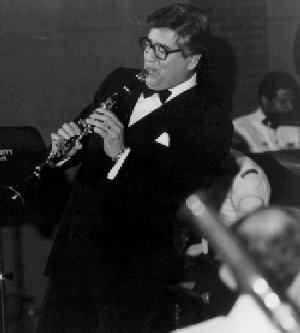
December 17, 2003
Henry Cuesta - in Memoriam
Los Angeles, California USA -
Henry Cuesta, highly
regarded star clarinetist best known as a featured musician with the
Lawrence Welk Orchestra, his technical mastery of the clarinet was often
compared to that of Benny Goodman. He performed with the Lawrence Welk
Orchestra on television and in concerts from 1972 until 1982, when
Welk's weekly program ended after 27 years on ABC Television and in
syndication. He was 71 years old when he succumbed to cancer. |

26 November 2003
Meyer Kupferman - In Memoriam
Rhinebeck, New York USA
Maverick modernist
composer with a special interest in jazz
Meyer Kupferman, composer: born New York 3
July 1926; married 1973 Pei Fen (one daughter); died near
Rhinebeck, New York 26 November 2003.
Meyer Kupferman was something of a maverick among
American composers, his own man in life as he was in music.
He took what he want from his musical environment - from
jazz as from 12-tone modernism - to form a style that
manages to be both modern and accessible. And he founded his
own record label to make sure the world heard it.
His family origins were colourful, though typical of many
immigrants to America. His father, Elias Staff-Cooperman,
born in Romania in 1900, fled from an oppressive stepfather
and made his living across mainland Europe as an itinerant
folk-singer, accordionist, wrestler, baker and cook. After
conscription into the Austro-Hungarian army, and being
wounded in action, he emigrated to the United States with
his sister in the early 1920s. He became a baker in New
York, changed his name to Kupferman (most immigrants
anglicised their names; he went the other way) to eradicate
any memory of his stepfather and, engaged to sing at a
wedding, met and fell in love with a Russian émigrée, Fanny
Hoffmann, who had fled from the anti-Semitic pogroms in the
Ukraine. Meyer was the fruit of their union.
His early years were unsettled, with the family moving to
a new apartment every year throughout, and after, the
Depression, yanking young Meyer from one school to another.
At the age of five he was put to the violin but showed
little interest in the instrument. But at 10 a chance
encounter with the clarinet changed his life. He took
lessons, found he enjoyed music, taught himself to compose
and play the piano and began to write music and arrangements
for his friends. As a teenager he became a regular performer
in the jazz clubs of Coney Island, Brooklyn, and enjoyed the
burgeoning of the big-band sound.
Although he was entirely self-taught as a composer, he
did take formal lessons in theory, chamber music and
orchestral music at the High School of Music and Art and at
Queens College. Another important ingredient in his musical
make-up came from his father, who encouraged his son's
musical development and sang him Hebrew, Romanian and gypsy
songs, which Meyer would follow with his clarinet - elements
which resurfaced intermittently in Kupferman's music in the
decades ahead, as in The Garden of my Father's House (1972)
for violin and clarinet, which is dedicated to his father's
memory.
Kupferman was only in his early twenties when, in 1951,
he took up a professorship in composition and chamber music
at Sarah Lawrence College and he stayed there for 43 years,
retiring only in 1994, his period there including five terms
as head of department. He conducted the orchestra and chorus
there as well as its chamber improvisation ensemble, took
classes in theory and film music and turned out a long
series of experimental works for the drama and dance
students.
Music poured from Meyer Kupferman over the course of his
six-decade composing career. His tally of symphonies reached
12, and he produced 10 concertos, for a variety of
instruments. His chamber works (which include seven string
quartets) can be counted by the hundreds - he wrote over 60
solo and chamber pieces for his own instrument, the
clarinet. He was attracted to the stage, too, eventually
writing no fewer than nine ballets and seven operas. There
are film scores (one of them for Truman Capote's Trilogy),
works combining electronic sounds and live performers, other
orchestral works besides the symphonies and concertos.
Although Kupferman first began to develop an interest in
12-tone writing - which avoids an established sense of key -
in the early 1950s, he was concerned that his music should
not lose the lyricism that had marked it until then. One of
his solutions was to use the same 12-note row in an extended
series of works, his Cycle of Infinities, which came to
comprise over 30 variegated concert pieces, written between
1962 and 1983, among them solo and chamber scores, a cantata
and a three-act opera, The Judgement (1966). Jazz, Jewish
melisma and a ready sense of humor gave listeners three more
handles with which to grasp his music.
Indeed, his familiarity with jazz made it inevitable that
it would figure as an influence in his concert music. Thus
he wrote a Concerto for Cello and Jazz Band, a Sonata on
Jazz Elements, a Jazz String Quartet (No 6 of his seven), a
Jazz Symphony - which he recorded in Lithuania in the summer
of 1990, in the teeth of the Russian blockade. And he wrote
about jazz, too: his two-volume Atonal Jazz, published in
1992, is an ambitious, detailed study of advanced chromatic
technique.
The conductor Jonathan Sternberg, saluting Kupferman's
"extraordinary imagination" and "fascinating personality",
found that he
was always able to contribute to any
conversation something of interest, regardless of the
subject. He knew the answers to everything musically.
At their last meeting,
already ailing, he revealed
disappointment [that] his creative qualities . . . were
still generally unrecognised, in favour of the massive trash
being served even by distinguished conductors . . . catering
to dumbed- down audiences.
It was characteristic of Kupferman's energy that he
didn't take his neglect lying down. Just as at the beginning
of his career, when he had roped in colleagues - among them
Morton Feldman, Seymour Shifrin and Allan Blank - to form an
ensemble called Composers' Workshop, so, too, he set up
Soundspells Productions to record his music. The label has
now released a generous quantity of Kupferman's output on CD
- though it's only the tip of a very large iceberg.
Martin Anderson
16 September 2003
Jack Brymer - In Memoriam
London, England -
Jack Brymer, one of the most important British Clarinet icons
of the last century, passed away on this date at age 88. As a long
standing orchestra soloist and solo clarinetist in the London Symphony, he has
pioneered the British Clarinet sound and style which is characteristic of the
British School of playing. Clarinets such as the Boosey-Hawkes Symphony 10-10
series, later evolving to makers such as Peter Eaton
and others, maintain the
British benchmark. Mr Brymer has been an active recording artist having
been probably the most recorded English artist on record, and has been one of
the most important teachers, on faculty at the Royal College of Music in London
and other schools. For many years he has been a high visibility member and
President of the Clarinet & Saxophone Society of Great Britain (CASS).
Jack Brymer will be remembered as a major legend for a long time to come.
Clarinettist Brymer chosen by Beecham for his innate musicality and rich
sound
June
Emerson
Thursday September 18, 2003
The Guardian
Jack Brymer,
who has died aged 88, was one of the finest clarinettists of the past
half-century. His professional career started when Sir Thomas Beecham appointed
him principal clarinet of the Royal Philharmonic Orchestra, and it went on to
include extensive concerto, chamber music and recital work.
Brymer was
unusual in that he came from the world of amateur music and jazz, and brought to
his orchestral playing a particularly warm and flexible tone. He considered it
essential to be a musician first and a clarinettist second, and it was his
outstanding musicianship, as well as his rich sound, that made his playing so
memorable.
Born in
South Shields, Brymer shared his birthday with Mozart, a composer of particular
significance to him. He first began to play on his father's clarinet as an
inquisitive four-year-old, and went on to make his own discoveries of music and
instrumental technique without formal tuition. Struggling with an inadequate
instrument (a sharp-pitch A clarinet with a bit sawn off in the school woodwork
room) and playing in local bands and amateur orchestras with people much older
than himself, he learned his craft in the most practical way.
This meant that
when he finally acquired a good pair of instruments, after some 13 years of
playing, he had already mastered many of the problems that he might encounter
later. He recalled buying his first pair of Boosey & Hawkes 1010s for £19,
handing over his old battered instruments in part exchange, together with all
his savings and £2 extracted from the gas meter.
He trained as a
teacher of general subjects, specialising in music, at Goldsmiths College,
London University, and went on to teach at Heath Clark School, Croydon, while at
the same time taking part in a great deal of amateur music-making.
He received
much encouragement and orchestral experience from playing under Frederick Haggis
in the Goldsmiths College orchestra, and from Ernest Read in the Ernest Read
Symphony Orchestra. It was at Goldsmiths that he first met Joan Richardson, a
violinist and viola player. They married in 1939, and Joan travelled with him
all over the world throughout his career.
At the
beginning of the second world war, the school was evacuated to
Eastbourne, but when things began to look dangerous it was transferred to
Llanelli, Wales. In
1940, he joined the RAF as a physical training instructor, doing his basic
training at Uxbridge. During his years of service, he met and played with many
professional musicians, but returned to teaching once the war was over. They
must have talked about his playing - though nobody ever admitted to it - because
one day in July 1947 there was a surprise telephone call from Beecham requesting
that Brymer audition the next day for the Royal Philharmonic Orchestra. He was
immediately appointed principal clarinettist as successor to Reginald Kell, and
held the appointment for the next 16 years.
These years
with Beecham were his golden period, packed with outstanding musical
experiences, some of them far from comfortable, as he recounted in his
autobiography From Where I Sit (1979). After Beecham's death in 1961, he became
co-principal clarinet in the BBC Symphony Orchestra (1963-71), and principal in
the London Symphony Orchestra (1971-86).
Brymer was a
founder-member of the Wigmore Ensemble, the Prometheus Ensemble and the London
Baroque Ensemble, director of the London Wind Soloists, and a member of the
Tuckwell Wind Quartet and the Robles Ensemble. He also taught at the Royal
Academy of Music, the Royal Military School of Music at Kneller Hall and the
Guildhall School of Music.
He recorded all
the wind music of Mozart, including the Clarinet Concerto three times. The
version he remembered with the most pleasure was the first, made in one session
in 1958 under Beecham. Several works were written for him, including Three
Pieces and a Clarinet Quintet by Armstrong Gibbs; Roundelay by Alan Richardson;
and Guy Woolfenden's Clarinet Concerto.
In his later
years, Brymer broadened his musical activities, describing himself as a
"soloist, chamber music player, teacher, orchestral player, broadcaster,
quizzer, lecturer, disc jockey, jazz fan, saxophone quartet leader, transport
organiser and map-reader, agent, accountant and tax-gatherer for HM government".
He relished the humorous moments thrown up by musical life, as once when he was
late for a concert and hailed a taxi driver. "Albert Hall," he yelled, "as quick
as you can, or quicker!" The driver didn't seem impressed. "How many in yer
outfit?" he asked. "Ninety," he was told. "Blimey, mate," he said, "they won't 'arf
miss yer!" He spoke truer than he knew.
Jack Brymer is
survived by his wife and his son Timothy.
Alan Hacker
writes: Jack Brymer took
the London postwar musical scene by storm. Vibrato, fairly new to classical
wind-playing, was the most obvious and novel aspect of his style. The legendary
oboist Leon Goossens, a member of Beecham's pre-war orchestra, was the first
wind player noted for vibrato. In using it, he was copying Fritz Kreisler, who
(according to Carl Flesch) had been the first violinist to play with continuous
vibrato. Goossens' colleague Reginald Kell then took the idea on board, though
Brymer told me he was playing the clarinet with vibrato before Kell.
Vibrato was by
no means all, though. Brymer's hallmark as a clarinettist was a very
soft-textured tone, which he aimed to produce at all dynamic levels. And most
important of all, his playing had a remarkable presence. Part of that could be
put down to the ease of his playing and a resonance of tone that no follower
could quite achieve. Like other members of the "Royal Family", as the woodwind
section of the Royal Philharmonic Orchestra was called, his sound was expressive
and instantly recognisable, even in just one solo note.
An uncle of
mine had been a fellow teacher in South Shields. Through this connection, I was
thrilled at the age of 16 to have a letter from the great Jack Brymer. I became
one of his students at the Royal Academy of Music, and went to hear him in
concerts as often as possible.
In a clarinet
solo from an orchestral work by Dvorak, the older generation of British and
continental players produced a woody folk colour, whereas Brymer would create a
soft romantic impression. I would wait with bated breath for his solos to begin.
"Float the tone," he would often say, emphasising the "idyll" rather than the
"epic" - Berlioz's terms for the clarinet's main characteristics.
The composer
Harrison Birtwistle, also a Brymer pupil, says that the most important
achievement of an instrumentalist is to bring about new compositions (by analogy
with Stadler for Mozart, and Mühlfeld for Brahms). But, surely, it is also
creative for a performer to influence other performers. "Alan is swimming
against the stream," Jack would say. But it was his confidence and the natural
relationship he had with his instrument that encouraged me in my way.
Jack Brymer,
clarinettist, born January 27 1915; died September 16 2003
18 August 2003
Vito Pascucci - in Memoriam
Kenosha, Wisconsin USA
Legendary maker and marketer of wind instruments, is dead at 80
Vito Pascucci, founder and chairman of the Kenosha, Wisconsinbased
G. Leblanc
Corporation, died on Monday, August 18, after a long period of declining health. Pascucci was an entrepreneur and a classic self-made man whose name grew to
legendary proportions within the music industry and among musicians. He was 80.
Born on Columbus Day, October 12, 1922, in Kenosha, Wisconsin, Vito was educated
in Kenoshas public schools, where he first learned to play trumpet. Pascucci
later served his country during World War II with the Glenn Miller Army Air
Corps Band. Stationed in Europe, he learned manufacturing techniques from the
most respected and progressive instrument maker of the time, Léon Leblanc.
Returning from the war, he cofounded G. Leblanc Corporation in America in 1946.
Over the years, he turned his original one-man shop into a nine-brand
corporation employing some 450 people and serving a world market from two
continents.
In
April 1989, Pascucci acquired controlling interest in G. Leblanc SNC, the French
parent company of the American corporation. In January 1993, he completed the
buyout. At the time of his death, he served as présidentdirecteur général of
the French firm.
True to their French roots, both companies will remain a family business in the
tradition of de père en fils, for Leon Pascucci, Vitos son and Léon Leblancs
namesake, will succeed his father as chairman of Leblanc USA and PDG of Leblanc
France. The younger Pascucci is a 32-year veteran of the American company, which
he has served as president and chief executive officer.
Vito Pascucci developed the only complete family of plastic-bodied clarinets
made in the United States, all with power-forged keys. The Vito brand woodwinds
that carry his name are manufactured by such advanced methods that they have
brought to student musicians a quality and consistency of instrument that was
previously available only to professionals.
Pascucci was a past chairman of the American Music Conference, and he served six
terms as president of the National Association of Band Instrument Manufacturers.
Among his many honors, Pascucci was named to the American Music Conference Hall
of Fame in 1980. In 1982, he received the Edwin Franko Goldman Memorial
Citation, the highest award of the American Bandmasters Association. In 1986, he
received the Air Force Commendation Medal for his morale-building efforts during
World War II, and in 1988, he was inducted into the Hall of Fame of the National
Association of Music Merchants.
In
recognition of his lifelong contributions to music education, Pascucci was
awarded honorary doctorates from Florida A&M University (Tallahassee FL, 1988),
Wartburg College (Waverly IA, 1993), the University of South Dakota (Vermillion
SD, 1995), and Berklee College of Music (Boston MA, 1998). Bandmasters Association presented to him its 2003 Lifetime Music Industry Award.
As further testament to Pascuccis unflagging attention to detail and quality,
for many years the Custom Tailors Guild included him on its annual list of Ten
Best-Dressed Men.
Vito Pascucci worked untiringly for the betterment of music for over 55 years.
His progressive attitudes toward manufacturing and his visionary approach to
marketing set new standards for the entire band-instrument industry.
|
|

|
|
Ignatius Gennusa in New Orleans
|
|

|
|
Memorial sign at Gennusa Concert in Maryland
|
|

|
|
American Symphonic Clarinet Choir Memorial Concert
|
|

|
|
American Symphonic Choir
|
|

|
|
Gennusa Mouthpiece display
|
|
|
24 May 2003
Ignatius Gennusa
(1920-2003) in Memoriam
We mourn the loss of
this great clarinetist Ignatius Gennusa, a major force in the Baltimore region
as former solo clarinetist in the Baltimore Symphony and for 40 years faculty at
the Peabody Institute. He has served on faculty at Catholic University and
for many years has been mentor to players from the Washington region. He
has been active as a mouthpiece maker with his distinctive facings and has
attended many Clarinet Conferences. The American Symphonic Clarinet Choir,
recently established by a former student Michael Kelly, and conducted by John
Stephens, performed a memorial performance in Gennusas honor 24 May in
Riderwood Village where Iggie Gennusa lived before his passing.
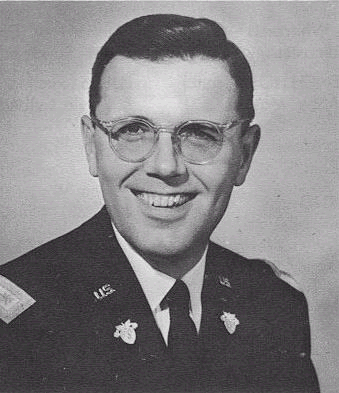
9 Jun 2002
Col William Schempf - In Memoriam
West Point, NY USA
It is with a great sense of personal loss to many members and veterans of the United States Military
Academy Band the passing of Colonel William Schempf, the 13th Teacher of Music and
Commander (incidentally a clarinetist) of that great Band between 1957-74. Many of the great
players served in the Band during this period. Under his tenure, the performance level of the Band
approached that of many major Symphony Orchestras, especially during the Vietnam War. Of special
significance from my own time in the Band between 68-73, and now rethinking what was so special
about him, was the keen interest in enhancing the musical standard of the Band and developing of his
members, including making possible the chance to study in New York at Schools such as Juilliard,
Manhattan School of Music, Columbia University, and other institutions. Under his leadership the
terms Mission Accomplishment and taking care of his people was overwhelmingly evident. He did
everything in his power to inspire self-accomplishment from his Band members, and was the
most selfless and generous Colonel to work for. I remember a very special concert held at the first night
of Klar/Fest '81 at Catholic University, where a 'reunion of sorts' had him conduct Stravinsky's L'Histoire
du Soldat with Steve Girko (veteran of the USMA Band and then Solo Clarinet in the Dallas Symphony,
and as narrator Robert Sherman from WQXR in New York. Karl Leister and Ignatius Gennusa
performed on the same concert. I would surmise that no Commander since has achieved the same
standard, and that William Schempf holds the most prestige of any West Point icon since the Band's
founding in 1817.
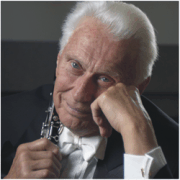
3 December 2001
Anthony Gigliotti
- in Memoriam
Philadelphia,
Pennsylvania USA
With a sense of sadness we mourn the passing of a great artist and
clarinetist Anthony Gigliotti, retired solo Clarinetist in the Philadelphia
Orchestra and Professor at the Curtis Institute of Music. Mr Gigliotti has been
a major icon in the Clarinet World as a great performer and teacher, evidenced
by success of his students and his advocacy of the field. In past years he has
brought about the development of the Selmer 10G series of clarinets, which have
become one of the main instruments of choice amongst players Internationally.
19 July 1997
Rosario Mazzeo - In Memoriam
Carmel, California USA
Rosario Mazzeo, one of the
most influential clarinet teachers of the century, passed away July 19, 1997,
in Carmel, California, at the age of 86. Clarinetist, bass clarinetist and
personnel manager of the Boston Symphony Orchestra for over thirty
years, he was also chairman of the woodwind department at the New England
Conservatory of Music. After his retirement from the orchestra, he moved to
California, where for a decade he presented a distinguished chamber music series
with the Crown Chamber Players at the University of California, Santa Cruz, and
enjoyed another thirty years of teaching at UCSC, Stanford University, and the
San Francisco Conservatory, and accepting distinguished pupils from all over
the world at his Carmel studio.
Hearing Rosario Mazzeo play clarinet for the first time in 1968 was
a revelation. As a player, he was noted for his incredible range of dynamics,
the warmth and beauty of his tone, and especially his committment to the score.
His perfectionism was so much a part of his nature that he left no commercial
recordings as a soloist.
Rosario Mazzeo had no use
for artistic temperament in his colleagues, himself, or his students.
He believed, more than any artist I have ever known, that the performer
should be the servant of the music, not the other way around. As far as I can
tell, he considered chamber music the greatest art of all, in part because of
the test of character it requires to perform it well.
He had a distinctive teaching style which was not at all based in
the student emulating the playing of the teacher. In fact, he had scorn for
multi-generational performance traditions which could not be supported from the
music itself. In the decade I worked with him, he never played a note at any of
my lessons. Instead he would use words and concepts, conduct, exhort, and
especially use his often blustery singing voice to demonstrate how a phrase
should go. In this, he was extraordinarily effective. His musical insights were
profound: this was probably his greatest single gift. If you had
a difference of opinion, you had to make it equally as convincing as the
phrasing that he heard in his head. Most of the time, the results
were better if you went with his concept. Making music for him in his studio was
actually a partnership: he was conducting, either physically or intellectually,
and the object was an ever higher musical ideal. For the student
who could appreciate his greatness, the realization of those ideals became an
almost sacred quest.
Unlike many famous artist-teachers, he was kind. He had no need to
tear down the ego of any of his students. His personal power, which drew able
students like a magnet, was the warmth and positivism of his personality, his
deep knowledge of the clarinet, and his ability to absolutely focus on the
student. When he was teaching, he was totally involved.
His
students mourn the passing of a great artist, but even more the loss of a
gentle, ebullient, and generous friend, who touched and changed our lives.
(text copyright 1997, Margaret Thornhill)
Copyright ©
1999 WKA-Clarinet.org. All rights reserved.
Revised: August 29, 2010


























